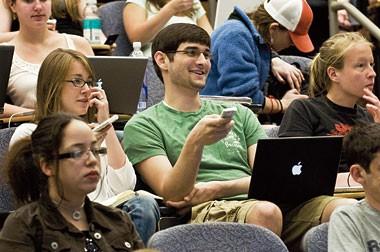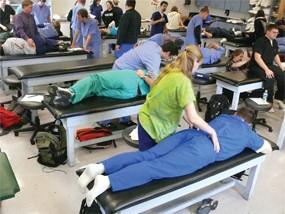Promoting “Active” Learning
in Your Teaching Lecture
David Hume D.O., ABFP Clinical Assistant ProfessorArizona College of Osteopathic Medicine




Midwestern University


Arizona College of Osteopathic Medicine




Midwestern University

Define active learning..
Understand why active learning is successful.
Become familiar with different forms of active learning.

Active learning is any wellstructured, teacher-guided, student-centered activity that “substantially involves students with the course content through talking and listening, writing, reading and reflecting.”
You might not remember this (we’ll come back to this point)


The student has to be engaged in higherorder thinking tasks such as:

- analysis - problem-solving
- synthesis - evaluation
Basically, higher thinking as opposed to passive learning.


Out of every 100 items in a passive lecture, students will remember approximately 1020.

Quick math. That’s 10-20% and that sucks.

Preferred by students
Stimulates higher order thinking/skills
Promotes learning in students with different learning styles

Students become motivated
Facilitates learning by the entire group





• Instructor taught in the traditional method
• Role of teacher is questioned
Perceived increase in preparation time
• Increased risk – students may not participate
• Lose control of class
• Labeled unorthodox
• ? Increase in class time






Guide Lectures - Collect immediate feedback about students' understanding of lecture topics so confusion can be addressed quickly.
Facilitate Class Discussion - Facilitate discussion by polling students' opinions and discussing the reasons for their opinions.

Encourage Peer Instruction - Allow students to share, discuss, and change their opinions before answering a question.
Collect Data and Perform Formative Assessment - Collect data on course topics or learning preferences throughout the cycle of a course.

Offer Quizzes and Exams
Take Attendance
Increase students' attention, interest, retention, and make learning fun!
Using clickers to pose questions that require synthesis of information, such as asking for an opinion on a complex social or ethical issue, promotes critical thinking and helps make learning personal.
Allow shy students to participate.
Allow anonymous, simultaneous, and fast response to instructor questions on class material or learning preferences.

Most common method for encouraging active learning

Most promote questioning and discussion
Encourages students to take risks-student might feel some discomfort (fear of being called on)
ACRONYMS
- ROYGBIV, SCUBA
SENTENCES
- Some lovers try positions that they can’t handle
RHYMES & SONGS
- Alphabet
METHOD OF LOCI

- Visual path and connection with items
Chunking
- Numbers (7-9 items) 86121996 or 8612-1996
1 - 2 minutes of pause every 18 minutes of lecture
This method has been found to increase the amount of content retained (Ruhl, Hughes, and Schloss 1987)
Successful in my small group lecture at Midwestern University











"learn best by doing, not by watching or listening".

The Ah-Ha! Moments.


According to Carl Rogers, the only learning that really sticks is that which is self discovered.



References
http://www.slideshare.net/DeirdreB/promo ting-active-learning-using-games
http://blogs.usask.ca/medical_education/a rchive/2006/03/active_learning.html

http://www.texascollaborative.org/activel earning.htm
http://medicaleducation.wetpaint.com/pa ge/Active+Engagement
http://activelearningcarnival.blogspot.co m/2008/02/assessing-active-learning-1.ht ml
Implement at least one new (to you) “active” learning strategy in your teaching this week.



What will you keep the same?
What will you do more of?
What will you do less of?
What will you stop doing?
What will you do differently & how will you do it?
What will you add?
Active learning is defined as any instructional method that engages students in the learning process. Active learning requires students to do meaningful activities and think about what they are doing. While this definition could include traditional activities such as homework, in practice it refers to activities introduced into the classroom. The core elements of active learning are student activity and engagement in the learning process. Active learning is often contrasted to the traditional lecture where students passively receive information.

Collaborative learning can refer to any instructional method in which students work together in small groups toward a common goal. As such, collaborative learning can be viewed as encompassing all groupbased instructional methods, including cooperative learning. In contrast, some authors distinguish between collaborative and cooperative learning. In either interpretation, the core element of collaborative learning is the emphasis on student interactions rather than on learning as a solitary activity

Cooperative learning can be defined as a structured form of group work where students pursue common goals while being assessed individually. A common model of cooperative learning incorporates five specific tenets: individual accountability, mutual interdependence, face-to-face promotive interaction, appropriate practice of interpersonal skills, and regular self-assessment of team functioning. The core element held in common is a focus on cooperative incentives rather than competition to promote learning.

Team-based Learning (TBL) is an instructional method that allows a single instructor to conduct multiple small groups simultaneously in one classroom. TBL stresses the importance of out-of-class learning based on learning objectives, emphasizes the importance of holding learners accountable for attending class prepared to participate, and provides guidelines for designing group learning tasks to maximize participation. Class time is shifted away from learning facts toward application and integration of information. The instructor retains control of content acting as both facilitator and content expert. TBL consists of repeating sequences of three phases: pre-class preparation, readiness assurance, and application of concepts.

DEFINITION
Case-Based Learning (CBL) is a learnercentered instructional approach where factually based, complex problems are used to stimulate discussion and collaborative analysis. CBL involves the interactive exploration of realistic and specific situations for which there is often no single correct solution.

Learning
Problem-based Learning (PBL) is a type of CBL where problems are introduced at the beginning of the instruction cycle to provide the context and motivation for learning. It is always active and usually collaborative or cooperative. PBL typically involves significant amounts of self-directed learning. Some evidence shows that PBL develops enhanced problem-solving skills in medical students and that these skills can be improved further by coupling PBL with explicit instruction in problem solving.
